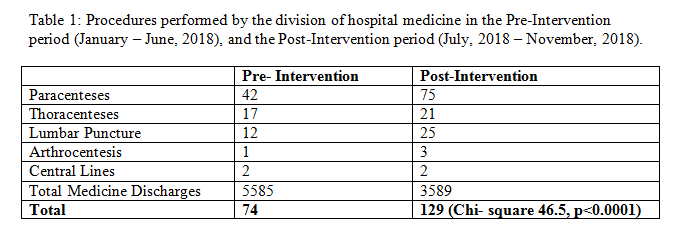Background: Internal medicine residency contains procedural training, including guidance in paracentesis, thoracentesis, lumbar puncture, arthrocentesis, and central line placement. As a result, most hospitalists are able to perform these bedside procedures. However, national trends confirm that these procedures are increasingly referred to interventional radiology, and these referrals are associated with higher direct hospital costs.1 Enhancing procedural capabilities by hospitalists could be a cost lowering strategy for hospitals, as well as revenue generating for hospital medicine groups.
Purpose: To create a hospitalist-run procedure team, offering access to paracentesis, thoracentesis, lumbar puncture, arthrocentesis, and central line placement, in order to optimize patient safety, diminish the need for interventional radiology referrals, and enhance the revenue generation for an academic hospital medicine division.
Description: In July, 2018 a procedure team was created, consisting of a hospital medicine faculty member and two internal medicine residents. The six faculty members staffing the team completed a CME course in bedside ultrasound, and were previously credentialed to perform procedures. The team acted as a seven day per week, daytime consult service for all inpatient services. In the first five months (July through November, 2018) 129 procedures were performed, including: 75 paracenteses, 21 thoracenteses, 25 lumbar punctures, 6 arthrocenteses, and 2 central lines. This was an increase from 77 procedures in the prior six months (January – June, 2018). This was a statistically significant increase in the number of procedures performed per inpatient medicine discharge, during the two time periods (p < 0.001, Table 1). Charges for these procedures were $86,498.00 as compared to $50,542.00 in the prior six month period, with otherwise net neutral cost structure. There were no reported complications in the post intervention period.
Conclusions: Creation of a hospital medicine procedure team is feasible, and provides access to proceduralists who are trained and capable of performing procedures to optimize the risk of complications. Development of this team requires appropriate training in ultrasound guidance and access to ultrasound and procedure equipment. A procedure team has the potential to enhance revenue for hospital medicine groups, while also saving direct hospital costs and enhancing delivery of high value care.
Reference:
Barsuk JH, Feinglass J, Kozmic SE, Hohmann SF, Ganger D, Wayne DB, Specialties Performing Paracentesis. J. Hosp. Med 2014;3;162-168

